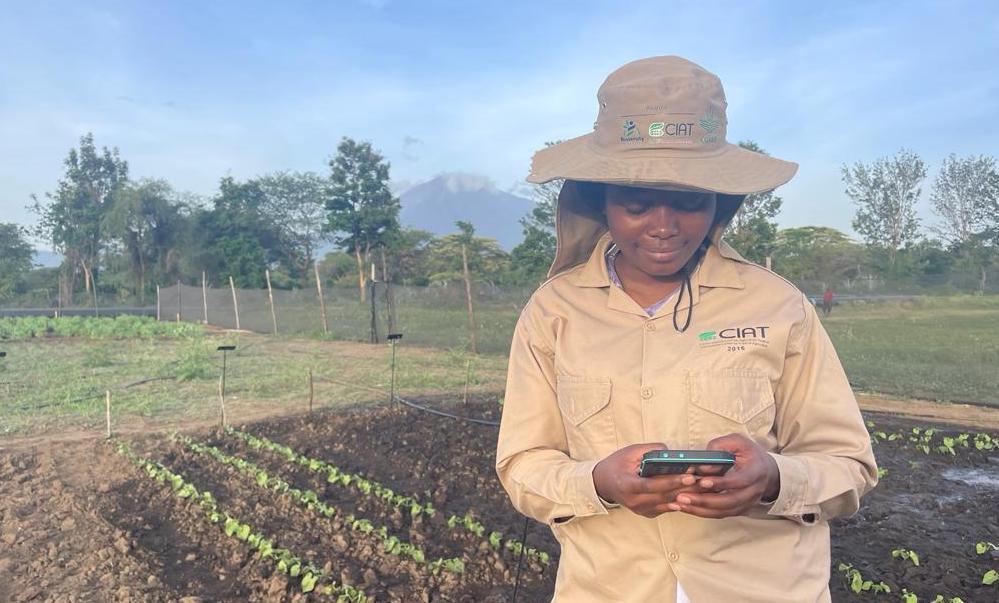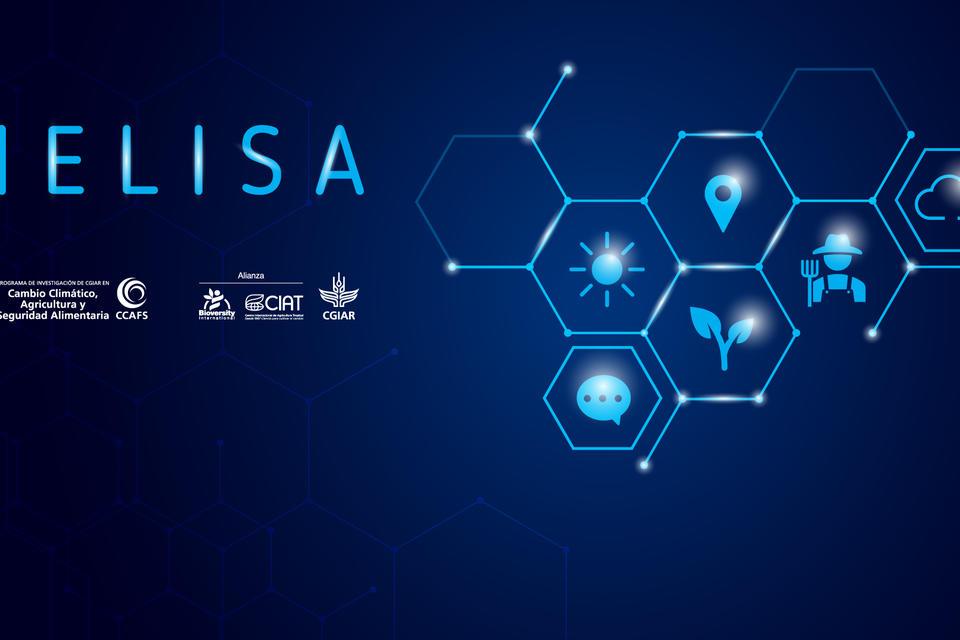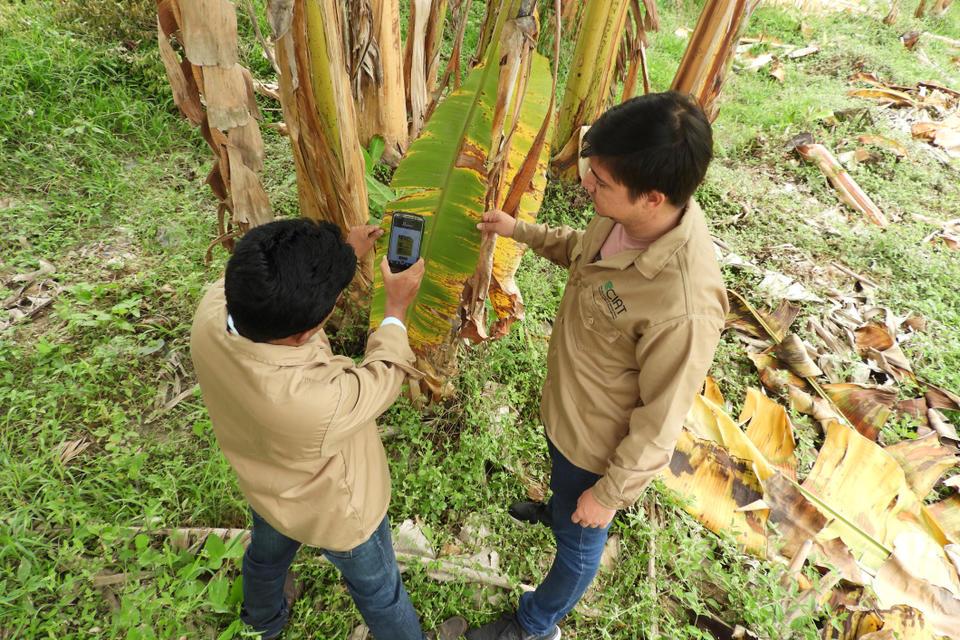Blog Artificial Intelligence: How could it transform agriculture?

AI is a controversial tool with powerful applications: including for how we grow our food. Below, we share examples of how researchers are already applying AI, and the considerations to sustainable and equitable use of this technology.
For most of us this year, the use of artificial intelligence (AI) has leapt from the realm of the possible to the inevitable. Sectors from healthcare to media are grappling with AI’s abilities, and agriculture is no exception. CGIAR scientists have already spent years exploring how AI can further efforts to sustainably grow resilient crops and ensure that farmers adapt to climate change.
Three ongoing Alliance projects that draw on AI include: Tumaini (a smartphone app allowing banana farmers to solve 90% of major diseases and pests); Melisa (a chatbot that estimates the maize and wheat yield of Colombian farmers based on long-term weather predictions, soil and crop varieties, and sowing dates); and Artemis (computer vision technology systems that enable crop breeders to develop locally-adapted, climate-resilient varieties).

Researchers in Tanzania are combining smartphone photos and AI to observe bean varieties in the field. Photo: David Guerena
Precision Agriculture: A Pathway to More Efficient Farming
Steve Mutuvi is a data scientist with a background in Large Language Models (the AI family behind ChatGPT). With his work at the Alliance in Tanzania, he sees many opportunities to integrate these concepts into plant breeding:
“Applications of AI include yield optimization by predicting optimal planting, irrigation and harvesting times for maximizing yield while minimizing resource use and adapting to a changing climate. AI models can simulate how climate change will impact agriculture, and recommend strategies to make farming more resilient with a lower environmental impact.”
Precision agriculture is a series of techniques using high-technology sensors and analytics to provide farmers with data to make informed decisions that minimize resource use and maximize yields. Precision agriculture tools are based on ‘machine learning’, which uses historical data to develop correlations between weather patterns, soil types, crop varieties, and external inputs, thus generating recommendations which can be provided to farmers in a variety of user-friendly formats.
One of the most valuable forms of AI-driven precision agriculture is crop monitoring: tracking crop health to offer tailored guidance for farmers to ensure a good harvest, simultaneously safeguarding their livelihoods and reducing waste.
Disease Diagnosis and Mitigation: Tumaini
Our first case study is ‘Tumaini’, which in Swahili means ‘hope’. Developed by Alliance scientists and local banana farmers, this easy-to-use app applies machine learning (analysis of phone, drone, and satellite images) to detect early signs of five common diseases and one major pest, which in the past has caused many farmers to lose their season’s entire harvest. It is simple to use: farmers upload a photo of an affected crop, the app compares the photo with a database of images categorized by location, and finally the app offers the farmer a diagnosis and a series of recommendations to solve the problem. Already in 2019, Tumaini trials in Colombia, the Democratic Republic of the Congo, India, Benin, China and Uganda returned a 90% rate of successful disease and pest detection. According to project leader Michael Selvaraj: “Tumaini AI has transformed GPS data into a vivid portrait of banana plant health worldwide: from 6,000 in 2013 to over 18,000 entries today”. Its latest step is to include another important crop: beans.
The Oracle of Yield Forecasting: Melisa
Using a different communication method to support maize and wheat producers in Colombia, in 2022 the Alliance launched ‘Melisa’: an AI-driven chatbot that provides accurate agro-climatic forecasts, allowing farmers to plan harvests, and prepare their products for market. Melisa is available to farmers on WhatsApp, Facebook and Telegram, and in the form of a chat, farmers can ask ‘Melisa’ for both short- and long-term weather predictions, as well as estimations of their maize and wheat yield for the coming season. Melisa uses a machine learning system that predicts farmers’ outputs by analyzing their soil type, the seed varieties used, the days they sowed the seeds, as well as the past and predicted climatic conditions. This information allows farmers to plan optimal harvesting dates, and estimate their income for the season.
Farmer-driven Phenotyping: Artemis
AI’s information-processing capacities can also empower farmers to cultivate more locally-adapted crops through faster and more accurate phenotyping (observing how crops perform to select the most promising varieties), accelerating the traditional process of plant breeding which farmers have done manually for thousands of years. AI speeds up this selection process by analyzing and comparing thousands of images of crop varieties, as they grow in the field. The Artemis project - a collaboration between the Alliance and the Alphabet company Mineral - has been using rovers and smartphones to help farmers and crop breeders identify the most productive and resilient seed varieties based on their location and unique growing conditions, at sites from Colombia to Tanzania.
Further Areas for Exploration
As well as crop monitoring and advisory services, another promising example of AI in agriculture is the installation of underground soil humidity sensors that could allow farmers to estimate irrigation needs, thus helping them use resources efficiently. AI could also help design automated smart irrigation systems – a complex process yet to be upscaled. Furthermore, advanced robotic technologies could automate manual tasks such as sowing and harvesting, thus reducing the time-consuming labor needs of farming, potentially saving money for farmers and reducing human error.
The Complexities of AI in Agriculture
Given that artificial intelligence is rapidly evolving and still yet to be fully understood, there are potential challenges for its implementation, including:
- Data privacy and security: AI relies on collecting large amounts of data on farmers’ practices and growing conditions, which could make them vulnerable to identity theft or the disclosure of confidential information. Data sharing risks could also make farmers wary of adopting AI technologies, making it hard to upscale the benefits these tools may provide.
- Dependence on technology: If farmers come to rely on AI tools for their planning, any disruption or technical failures could put their operations and productivity at risk.
- Unequal access: Depending on pricing, some small-scale farmers may not have the financial capacity to afford access to AI technologies. This could cause inequality in favor of larger producers, putting small-scale farmers at a disadvantage, leading to further inequality; this raises the question of how such technologies could be made available to these farmers free of charge.
- Job displacement: The potential of automating farming labor by using rovers or robots could put farmworkers at risk of losing their jobs, potentially creating wider economic and social difficulties.
- Monoculture vs agrobiodiverse systems: AI’s focus on minimum input and maximum efficiency and yield may not work for farmers who intend to adopt agroecological practices. Creating biodiverse farming systems with approaches such as agroecology is seen as an important way to restore and protect ecosystems that have been affected by industrial agriculture and chemical inputs. A variety of farming methods must be explored, but considering the importance of agrobiodiversity, AI tools could create a bias in favor of monoculture.
- Ethical concerns: AI’s potential to contribute to genetic modification provokes many ethical questions and debates. While the possibility of modifying seeds to increase yields may contribute to food security – one of the world’s most pressing concerns – even natural seed selection processes through phenotyping may reduce public trust and acceptance of these technologies.
- Environmental impacts: While AI could increase resource efficiency by predicting accurate needs for irrigation and other inputs, if adopting these tools creates a bias towards monoculture and incentivizes chemical inputs, this could reverse the gradual advances of agrobiodiversity. Furthermore, upscaling these tools also requires resources needs, possibly leading to yet-unknown negative environmental impacts.
How are Alliance's researchers addressing these risks? Berta Ortiz is a specialist in human-centered design who is integrating participatory approaches into Artemis’ work in Tanzania. She says:
“Inclusive design can overcome some of the issues faced by artificial intelligence by identifying the diverse needs of those that will use the AI tools, ensuring that they suit their unique contexts.”
The first step to recognizing and avoiding problematic applications of AI is to work with end users - local farmers and breeders - from the very beginning.
Overall, while artificial intelligence has massive potential to improve food production, it is simply an additional tool for researchers, breeders, and farmers, and requires careful use to yield the best results. As the importance of AI grows in all sectors, CGIAR and the Alliance will continue to develop and deploy these tools for the benefit of farmers first, as part of the transition towards sustainable and equitable food systems.







